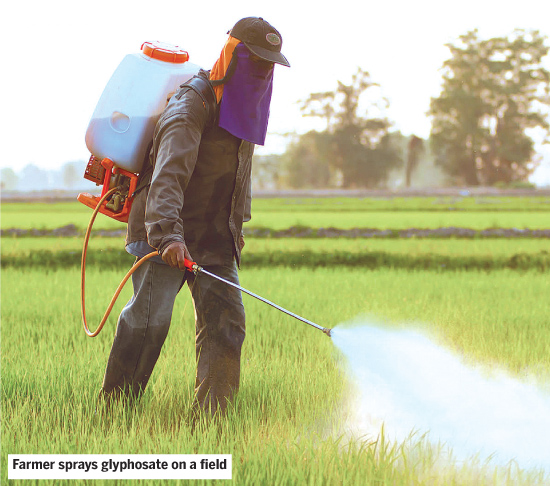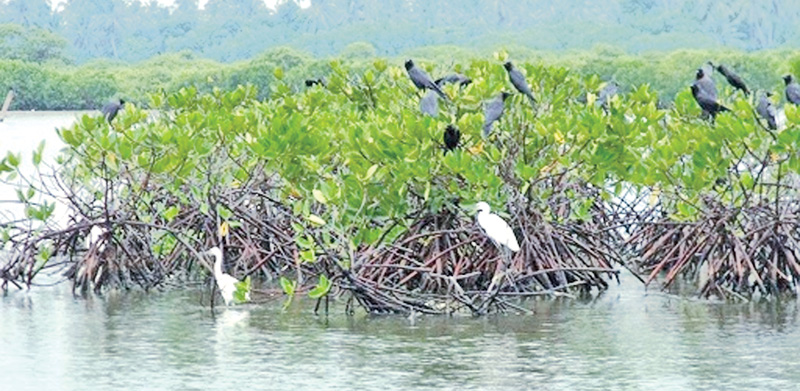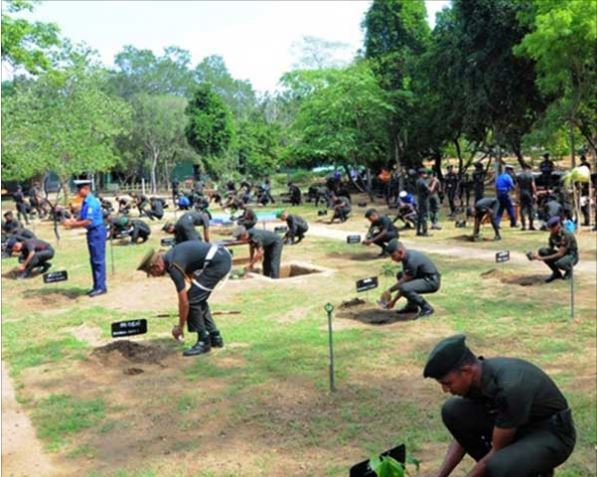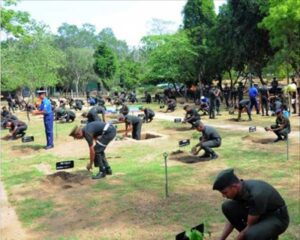
Court requested to release elephants for processions
The domesticated elephant protection association has requested the Court to release all licensed elephants for the religious processions.
The chairman of the association Ven. Magalkande Sudaththa Thero, stated that due to the religious processions taking place at this time of the year, the elephants need to be released as they are a key part of the procession itself.
The court will give their verdict on the matter today (26).
Ven. Magalkande Sudaththa Thero, brought these statements out during a media briefing held yesterday (25).
Source – 26/07/2017,Ada Derana, See more at – http://www.adaderana.lk/news/42163/court-requested-to-release-elephants-for-processions-

Is the herbicide Glyphosate safe?
It was reported in recent issues of several local newspapers that a four-member cabinet subcommittee has been appointed to study a cabinet paper that seeks permission for a limited use of glyphosate (often known by its original brand name, Roundup) in the plantation sector. The cabinet paper apparently had been submitted on the basis of a report by a committee appointed to make recommendations with regards to the pesticide and insecticide policy to the ministerial committee on economic management. This review of the decision is to reconsider the existing ban on glyphosate, a widely used chemical weedicide, to boost dwindling tea crops by cost-effective removal of overgrowing weeds in tea lands.
The request by the plantation management to control weeds in their tea plantations ‘efficiently’ by chemical means, as had been done in the past before the ban, in order to resuscitate the dwindling tea industry, particularly in the mountainous watershed areas of the country, is understandable from their short-term economic perspective. However, at a time when the Government is committed to sustainable development, in which the costs of the overall negative impacts of health aspects all-round (using internationally accepted precautionary principle in the absence of concrete evidence, as yet) also need to be given its due consideration in an era of moving towards an all inclusive Sustainable Development and Green Economy in the longer term.
Rethinking tea 150 years on
 Perhaps, this may be an ideal juncture, at a time the Sri Lankan tea industry is celebrating its 150 years of existence, to re-examine their economic development strategies in the light of the impact of their current plantation management systems on ecosystem services such as soil and water conservation, nutrient cycling and maintenance of soil fertility etc. and also their commitment to sustainable eco-friendly agricultural development. If these eco-friendly measures are taken into consideration by the tea plantation industry, it will help to get premium prices with lesser amount of lands used for tea and using lesser amount of labour which is already an issue in the plantations. With respect to cash crop agriculture as a whole, there needs a complete revamp of the present day agricultural and tree crop cultivation systems, particularly in our mountainous watershed areas.
Perhaps, this may be an ideal juncture, at a time the Sri Lankan tea industry is celebrating its 150 years of existence, to re-examine their economic development strategies in the light of the impact of their current plantation management systems on ecosystem services such as soil and water conservation, nutrient cycling and maintenance of soil fertility etc. and also their commitment to sustainable eco-friendly agricultural development. If these eco-friendly measures are taken into consideration by the tea plantation industry, it will help to get premium prices with lesser amount of lands used for tea and using lesser amount of labour which is already an issue in the plantations. With respect to cash crop agriculture as a whole, there needs a complete revamp of the present day agricultural and tree crop cultivation systems, particularly in our mountainous watershed areas.
On the other hand, it is also a national obligation of the Sri Lankan scientific community to monitor long-term impacts of the current land use pattern that requires continuous use of chemical weedicides, pesticides and insecticides in tea, vegetable and other commercial crop cultivations in the watershed areas.
Coming back to the issue of revision of the current ban on Glyphosate, a number of scientific reports are emerging in the international literature both for and against its use in controlling weeds which the ministerial subcommittee and/or their advisors should be looking at before making their decision with far reaching impact.
How safe is glyphosate?
One of such excellent appraisals of recent origin is from two scientists, Dr. Vijay Paul and Dr. Rakesh Pandey from the Indian Agricultural Research Institute who have made an exhaustive review of the literature available on the safety of glyphosate – [N-(phosphonomethyl) glycine] in the journal, Current Science Volume 112, No. 1, January 10, 2017 (Journal Impact Factor 0.843 in 2016/17). This article may be downloaded from the web to get scientific details (http://www.currentscience.ac.in/Volumes/112/01/0011.pdf) some of which I wish to highlight for the general readership.
Glyphosate is one of the most common and largest selling herbicides worldwide, having first registered in the US in 1974. It is a water-soluble, systemic (absorbed through leaves and also roots) and broad spectrum (non-selective) herbicide. It inhibits the biosynthesis of several amino acids by blocking an enzyme in these amino acid biosynthetic pathway in plants as well as in microorganisms (that include beneficial bacteria in the human gut and those in the soils that contribute to maintain soil fertility), but not in animals including humans.
 The aforesaid Indian article quotes several international scientific publications which report that continuous and long-term exposure to glyphosate is responsible for a multitude of modern human diseases, including gastrointestinal disorders, obesity, diabetes, heart disease, depression, autism, chronic obstructive pulmonary disease (COPD), pulmonary edema, adrenal insufficiency, hypothyroidism, infertility, cancer, Alzheimer’s disease, amyotrophic lateral sclerosis (ALS), Parkinson’s disease, prion diseases, lupus, non-Hodgkin’s lymphoma, neural tube defects, hypertension, glaucoma, osteoporosis, fatty liver disease and kidney failure, celiac disease and gluten intolerance.
The aforesaid Indian article quotes several international scientific publications which report that continuous and long-term exposure to glyphosate is responsible for a multitude of modern human diseases, including gastrointestinal disorders, obesity, diabetes, heart disease, depression, autism, chronic obstructive pulmonary disease (COPD), pulmonary edema, adrenal insufficiency, hypothyroidism, infertility, cancer, Alzheimer’s disease, amyotrophic lateral sclerosis (ALS), Parkinson’s disease, prion diseases, lupus, non-Hodgkin’s lymphoma, neural tube defects, hypertension, glaucoma, osteoporosis, fatty liver disease and kidney failure, celiac disease and gluten intolerance.
Another recently reported adverse impact of glyphosate is severe depletion of serum Mn and disruption of bile acid homeostasis and in this way glyphosate can promote autism, Alzheimer’s disease, Parkinson’s disease, anxiety disorder, osteoporosis, inflammatory bowel disease, renal lithiasis, osteomalacia, cholestasis, thyroid dysfunction and infertility. It further states that all the above conditions can be substantially explained on the basis of defective regulation of Mn utilization in the body due to glyphosate.
Additionally, glyphosate contamination has contributed towards the increase in chronic and acute kidney failure, pancreatitis, different types of cancers, various disorders, especially to newborns, not only in humans, but in animals as well. A study published in 2013 reports that the incidences of above diseases/conditions are also rising in many countries with the rise in the use of glyphosate on core/edible crops. Having used glyphosate world over for several decades, its possible health impacts are becoming increasingly evident in scientific literature.
On the basis of these increasing scientific evidence, the World Health Organization’s International Agency for Research on Cancer (IARC) classified glyphosate as a ‘probable carcinogen’ in 2016. However, a later statement issued by the experts from the U.N.’s Food and Agricultural Association (FAO) and World Health Organization (WHO) completely overturned their earlier decision and stated that glyphosate is unlikely to pose a carcinogenic risk to humans. The European Chemicals Agency in early 2017 has given an all-clear certificate, concluding that it is not linked to heightened risk of cancer in people.
This debate on the safety of glyphosate continues to rage as to whether it is associated with a heightened risk of cancer or whether it has the potential to disrupt hormone function and other associated disorders. Some researchers claim that the safety standards used to evaluate glyphosate in the US were prepared more than 30 years ago and based on out- of-date science and may not be able to address the full complement of potential hazards associated with long-term exposure to these chemicals which are now surfacing worldwide. Consequently, these safety standards need urgent review as they may be failing to protect public and environmental health, these researchers claim.
There are several other important issues that have not been adequately addressed by both groups of scientists. One such issue is the use of so called ‘inert ingredients’ that are mixed with glyphosate – the active ingredient- in the preparation of the weedicide mixtures for commercial purposes. These may be even more potent and more harmful than the active ingredient -glyphosate. However, these mixtures being regarded as commercially sensitive formulations by the manufacturers and are therefore, not available for public scrutiny. As such, their chemical composition is not appearing on the label of the product package, according to expert scientists. Consequently, proper scientific investigations should examine the effects of these commercial formulations, as well.
Glyphosate resistant weeds
One of the more serious ecological consequences emerging from the repeated use of glyphosate (or any pesticide, herbicide or insecticide, for that matter) over a long period of time is the development of glyphosate resistant weeds. At least 15 species of weeds have developed resistance to glyphosate in the U.S., and resistant weeds are spreading around the world, according to the International Survey of Herbicide Resistant Weeds. Once an important weed-control tool, glyphosate is now unreliable, even for farmers who have never planted genetically modified crops.
Please see the following reference for more details: http://cen.acs.org/articles/93/i37/Rocky-Road-Roundup.html
This international debate will, no doubt, continue to protract for decades (as in the case of cigarette smoking and cancer debate) due to confrontational approaches taken by vested interests as seen in the readers ‘comments on articles on the web. But the Sri Lankan scientific community following the Indian initiative mentioned above, should avoid getting entangled in these verbal diatribes and instead should accelerate long-term interdisciplinary studies already initiated on the health and environmental impacts of improper use of agrochemicals in our own agro-ecosystems, particularly those in the watershed areas. In this regard, an interdisciplinary study of land use (or mis-use) patterns in a the upper reaches of a river basin or in a sub-basin, at least, and an economic valuation of the ecosystem services they offer (or they deny) may be in line with our compliance with the Sustainable Development Goals (SDGs), in particular, the SDG Target 15.3 which states that ‘by 2020, integrate ecosystem and biodiversity values into national and local planning, development processes, poverty reduction strategies and accounts’. As a necessary extension, such studies currently being done in traditional lowland cascade (Ellangawa) systems need to be expanded further.
Such projects not being of ‘mega-scale’ may not appeal to most politicians and as such, would not get the priority green light for implementation although we are committed to a green economy in this ‘Blue-Green Era’.
However, robust science coupled with traditional wisdom continued over many generations with a proven history of ‘starting small and ending big’ rather than the other way around would no doubt, prevail at the end, in this era of sustainable development.
We hope that the ministerial subcommittee would not only look at this problem in a short-term sectoral development perspective, but in a holistic manner in accordance with the national obligations to international agreements safeguarding health of humans and the environment of this island nation already burdened with many a man-made cataclysms.
(The writer is Professor Emeritus at the Peradeniya University)
Source – 26/07/2017, Daily News , see more at – http://www.dailynews.lk/2017/07/26/features/123193/herbicide-glyphosate-safe

Supreme Court stays garbage dumping at Muthurajawela till August 3
The Supreme Court today further extended its Interim Order till August 3, preventing authorities including the Colombo Municipal Council (CMC) from dumping garbage in the Muthurajawela Sanctuary.
Three-judge-bench comprising Chief Justice Priyasath Dep, Justice Anil Goonaratne and Justice Nalin Perera made this order pursuant to a fundamental rights petition filed by 35 five residents in the close proximity of the Muthurajawela Sanctuary seeking an Interim Order directing the authorities not to store or dump garbage in the Sanctuary.
Additional Solicitor General Sanjay Rajaratnam appearing for the respondents had informed Court that the CMC was not disposing garbage at the Muthurajawela Sanctuary.
The petitioners cited Colombo Municipal Council (CMC), CMC Municipal Commissioner, Urban Development Authority (UDA), Central Environment Authority (CEA), the Wattala Pradeshiya Sabha and six other parties as respondents.
The petitioners further stated that the petitioners and their families and other residents of the close proximity of Muthurajawela Sanctuary have been severely affected and continue to be affected by this dumping.
The petitioners further stated that the area in question is declared a sanctuary under the Flora and Fauna Protection Act by the gazette dated 31.10.1996 in recognition of its vast bio-diversity.
The petitioners further stated that the Muthurajawela is also a large paddy field and it also consist of water canals, marsh lands and the forest.
As per the register of the Agrarian Development Office of the area shows that the total extent of paddy fields in the Muthurajawela amount to 635 acres and a marsh and mangrove amounts to 7,000 acres, the petitioners added.
The petitioners stated that by the said action of dumping garbage in to the sanctuary without any authority or following property procedures, the authorities who allowed and commit such acts have violated the Laws of the country including Section 33(1) and 34(1) of the Agrarian Development Act No.46 of 2000, Section 7(1) (h) (i), Section 7(1) (c) (ii) of the Flora and Fauna Protection Ordinance.
The said acts done by the CMC have infringed Fundamental Rights of the petitioners as well as of the members of the general public guaranteed to them by them by Article 12(1) and 14(1) (g) and the Fundamental Right to life which is also constituted and guaranteed by the Constitution of the republic.
The petitioners further sought a declaration on the respondents to take necessary actions and appropriate steps to ensure that no garbage is deposited and dumped in the Muthurajawela Sanctuary.
Source – 25/07/2017, Daily News, See more at – http://www.dailynews.lk/2017/07/25/local/123132/supreme-court-stays-garbage-dumping-muthurajawela-till-august-3

Herbal garden at CTS
All staffers, instructors and trainees at the Combat Training School (CTS), Ampara, together launched a new ‘Osu Uyana’ (Herbal Garden) after planting 100 indigenous species within the premises recently.
The simple planting ceremony took place in the presence of the CTS Commandant, Major General Shantha Dissanayake.
Senior Non-Commissioned Officers (SNCOs) and Non-Commissioned Officers (NCOs) under training in the ongoing ‘Leadership Development Course No 15’ also joined in the planting ceremony. (MT)
Source – 25/07/2017, Ceylon today, See more at – http://www.ceylontoday.lk/article20170401CT20170930.php?id=5794







